| Italy | |
|---|---|
 A frecciarossa high-speed train next to an older E.444R at Milano Centrale A frecciarossa high-speed train next to an older E.444R at Milano Centrale | |
| Operation | |
| National railway | Ferrovie dello Stato |
| Major operators | Trenitalia (national) Nuovo Trasporto Viaggiatori (national) Trenord (local) Trenitalia Tper (local) Thello (international) Mercitalia (freight) |
| Statistics | |
| Ridership | 883.3 million (2019) |
| System length | |
| Total | 16,832 km (10,459 mi) |
| Double track | 7,734 km (4,806 mi) |
| Track gauge | |
| Main | 1,435 mm (4 ft 8+1⁄2 in) standard gauge |
| Electrification | |
| 3 kV DC | conventional lines |
| 25 kV AC | high-speed lines |
The Italian railway system is one of the most important parts of the infrastructure of Italy, with a total length of 24,567 km (15,265 mi) of which active lines are 16,832 km (10,459 mi). The network has recently grown with the construction of the new high-speed rail network. Italy is a member of the International Union of Railways (UIC). The UIC Country Code for Italy is 83.
The network
See also: Narrow-gauge railways in Italy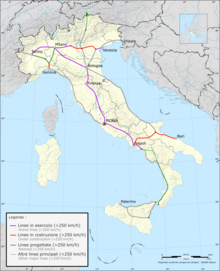
RFI (Rete Ferroviaria Italiana, Italian Rail Network), a state owned infrastructure manager which administers most of the Italian rail infrastructure. The Italian railway system has a length of 19,394 km (12,051 mi), of which 18,071 km (11,229 mi) standard gauge. The active lines are 16,723 km (10,391 mi), of which 7,505 km (4,663 mi) are double tracks. Italy has 2,507 people and 12.46 km per kilometre of rail track, giving Italy the world's 13th-largest rail network.
Lines are divided into 3 categories:
- fundamental lines (fondamentali), which have high traffic and good infrastructure quality, comprise all the main lines between major cities throughout the country. Fundamental lines are 6,460 km (4,010 mi) long;
- complementary lines (complementari), which have less traffic and are responsible for connecting medium or small regional centres. Most of these lines are single track and some are not electrified;
- node lines (di nodo), which link complementary and fundamental lines near metropolitan areas for a total 950 km (590 mi).
Most of the Italian network is electrified (11,921 km (7,407 mi)). The electric system is 3 kV DC on conventional lines and 25 kV AC on high-speed lines.
A major part of the Italian rail network is managed and operated by RFI (Rete Ferroviaria Italiana, Italian Rail Network). Other regional agencies, mostly owned by public entities such as regional governments, operate on the Italian network.
Travellers who often make use of the railway during their stay in Italy might use rail passes, such as the European Interrail / Eurail passes or Italy's national and regional passes. These rail passes allow travellers the freedom to use regional trains during the validity period, but all high-speed and intercity trains require up to a 15-euro reservation fee. Regional passes, such as "Io viaggio ovunque Lombardia", offer one-day, multiple-day and monthly periods of validity. There are also saver passes for adults, who travel as a group, with savings up to 20%. Foreign travellers should purchase these passes in advance so that the passes can be delivered by post prior to the trip. When using the rail passes, the date of travel needs to be filled in before boarding the trains.

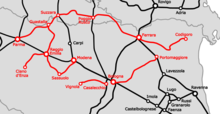
Companies certified to run railways in Italy are:
- From 2000
- Ferrovie dello Stato S.p. A.
- Trenitalia S.p. A.
- From 2001
- Metronapoli S.p. A.
- Ferrovie Nord Milano Esercizio S.p. A.
- Rail Traction Company S.p. A.
- From 2002
- Del Fungo Giera Servizi Ferroviari S.p. A.
- Gruppo Torinese Trasporti S.p. A.(ex SATTI)
- SERFER Servizi Ferroviari S.r.l.
- Hupac S.p. A.
- From 2003
- Ferrovie Emilia Romagna S.r.l.
- La Ferroviaria Italiana S.p. A.
- Cargo Nord S.r.l.
- Ferrovie Adriatico Sangritana S.r.l.
- Sistemi Territoriali S.p. A.
- Strade Ferrate del Mediterraneo S.r.l.
- Swiss Rail Cargo Italy S.r.l.
- From 2004
- SBB Cargo Italia S.r.l.
- Ferrovie Nord Cargo S.r.l.
- Azienda Consorziale Trasporti di Reggio Emilia
- Ferrovia Alifana e Benevento Napoli S.r.l.
- Ferrovie Nord Milano Trasporti S.r.l.
- From 2005
- Trasporto Ferroviario Toscano S.p. A. (La Ferroviaria Italiana S.p. A.)
- Ferrovie Centrali Umbre S.r.l.
- Railion Italia S.r.l. (ex S.F.M.)
- Rail One S.p. A.
- Azienda Trasporti Collettivi e Mobilità S.p. A.
- A.T.C. Bologna S.p. A.
- Monferail S.r.l.
- From 2006
- SAD - Trasporto Locale S.p.A.
- Nord Cargo S.r.l. (ex Ferrovie Nord Cargo S.r.l.)
- Arenaways S.p.A.
History
Main article: History of rail transport in Italy Rail network in Italy 1861-1870 Network as of 17 March 1861
Network as of 17 March 1861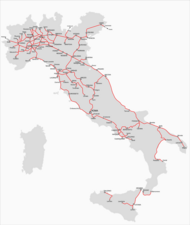 Network as of 20 September 1870
Network as of 20 September 1870
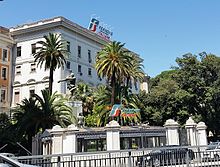


The first line to be built on the peninsula was the Naples–Portici line, in the Kingdom of the Two Sicilies, which was 7.64 km (4.75 mi) long and was inaugurated on 3 October 1839, nine years after the world's first "modern" inter-city railway, the Liverpool and Manchester Railway. The following year the firm Holzhammer of Bolzano was granted the "Imperial-Royal privilege" to build the Milano–Monza line (12 km (7.5 mi)), the second railway built in Italy, in the then Kingdom of Lombardy–Venetia, a part of the Austrian Empire.
After the creation of the Kingdom of Italy in 1861, a project was started to build a network from the Alps to Sicily, in order to connect the country. After unification, construction of new lines was boosted: in 1875, with the completion of the section Orte-Orvieto, the direct Florence–Rome line was completed, reducing the travel time of the former route passing through Foligno-Terontola. Private companies were definitively bought back by the Italian state on 1 July 1905, with the creation of the Ferrovie dello Stato (State Railways), or FFSS, with a total of 10,557 km (6,560 mi) of lines, of which it already owned 9,686 km (6,019 mi). The move was completed the following year with the acquisition of the remaining SFM network: by then FFSS possessed 13,075 km (8,124 mi) of lines, of which 1,917 km (1,191 mi) with double tracks.
The period from 1922 to 1939 was heavy with important construction and modernisation programmes for the Italian railways, which also incorporated 400 km (250 mi) from the Ferrovie Reali Sarde of Sardinia. The most important programme was that of the Rome–Naples and Bologna–Florence direttissimas ("most direct lines"): the first reduced the travel time from the two cities by an hour and a half; the second, announced proudly as "constructing Fascism", included the second longest tunnel in the world at the time. Electrification on 3,000 V direct current was introduced, which later supplanted the existing three-phase system. Other improvements included automatic blocks, light signals, construction of numerous main stations (Milan Central, Napoli Mergellina, Roma Ostiense and others) and other technical modernisations. The first high-speed train was the Italian ETR 200, which in July 1939 went from Milan to Florence at 165 km/h (105 mph), with a top speed of 203 km/h (126 mph). With this service, the railway was able to compete with the upcoming aeroplanes. The Second World War stopped these services.
After World War II, Italy started to repair the damaged railways and built nearly 20,000 km (12,000 mi) of new tracks. Entire lines were out of action and much of the rolling stock was destroyed. Thanks to the Marshall Plan, in the following years they could be rebuilt, although the possibility of reorganizing the network was missed due to short-sighted policies. The main Battipaglia-Reggio Calabria line (running along the west coast) was doubled, while a program of updating of infrastructures, superstructures, services, colour-light signalling and cars was updated or extended. The three-phase lines were gradually turned into standard 3,000 V dc lines.
Increasing numbers of steam locomotives were replaced by electric or diesel ones; in the 1960s also the first unified passenger cars appeared and the first attempts of interoperability with foreign companies were started, culminating in the creation of Trans Europe Express services. Nowadays the rail tracks and infrastructure are managed by Rete Ferroviaria Italiana (RFI), while the train and the passenger section is managed mostly by Trenitalia. Both are Ferrovie dello Stato (FS) subsidiaries, once the only train operator in Italy.
High-speed rail
Main article: High-speed rail in Italy


High-speed trains were developed during the 1960s. E444 locomotives were the first standard locomotives capable of top speed of 200 km/h (125 mph), while an ALe 601 electrical multiple unit (EMU) reached a speed of 240 km/h (150 mph) during a test. Other EMUs, such as the ETR 220, ETR 250 and ETR 300, were also updated for speeds up to 200 km/h (125 mph). The braking systems of cars were updated to match the increased travelling speeds.
On 25 June 1970, work was started on the Rome–Florence Direttissima, the first high-speed line in Italy and in Europe. It included the 5,375-metre-long (3.340 mi) bridge on the Paglia river, then the longest in Europe. Works were completed in the early 1990s.
In 1975, a program for a widespread updating of the rolling stock was launched. However, as it was decided to put more emphasis on local traffic, this caused a shifting of resources from the ongoing high-speed projects, with their subsequent slowing or, in some cases, total abandonment. Therefore, 160 E.656 electric and 35 D.345 locomotives for short-medium range traffic were acquired, together with 80 EMUs of the ALe 801/940 class, 120 ALn 668 diesel railcars. Some 1,000 much-needed passenger and 7,000 freight cars were also ordered.
In the 1990s, work started on the Treno Alta Velocità (TAV) project, which involved building a new high-speed network on the routes Milan – (Bologna–Florence–Rome–Naples) – Salerno, Turin – (Milan–Verona–Venice) – Trieste and Milan–Genoa. Most of the planned lines have already been opened, while international links with France, Switzerland, Austria and Slovenia are underway.
Most of the Rome–Naples line opened in December 2005, the Turin–Milan line partially opened in February 2006 and the Milan–Bologna line opened in December 2008. The remaining sections of the Rome–Naples and the Turin–Milan lines and the Bologna–Florence line were completed in December 2009. All these lines are designed for speeds up to 300 km/h (190 mph). Since then, it is possible to travel from Turin to Salerno (ca. 950 km (590 mi)) in less than 5 hours. More than 100 trains per day are operated.
Other proposed high-speed lines are Salerno-Reggio Calabria (connected to Sicily with the future bridge over the Strait of Messina), Palermo-Catania and Naples–Bari.
The main public operator of high-speed trains (alta velocità AV, formerly Eurostar Italia) is Trenitalia, part of FSI. Trains are divided into three categories (called "Le Frecce"): Frecciarossa ("Red arrow") trains operate at a maximum of 300 km/h (185 mph) on dedicated high-speed tracks; Frecciargento (Silver arrow) trains operate at a maximum of 250 km/h (155 mph) on both high-speed and mainline tracks; Frecciabianca (White arrow) trains operate at a maximum of 200 km/h (125 mph) on mainline tracks only.
Since 2012, a new and Italy's first private train operator, NTV (branded as Italo), run high-speed services in competition with Trenitalia. Even nowadays, Italy is the only country in Europe with a private high-speed train operator.
Construction of the Milan-Venice high-speed line began in 2013 and in December 2016 the Milan-Treviglio-Brescia section has been opened to passenger traffic; the Milan-Genoa high-speed line (Terzo Valico dei Giovi) is also under construction.
Today it is possible to travel from Rome to Milan in less than 3 hours (2h 55' without intermediate stops) with the Frecciarossa 1000, the new high-speed train. As of June 2024, there are 46 Trenitalia and 33 Italo round-trip high-speed trains every weekday that cover this route,
Night trains
Main article: Nightjet
The Nightjet of the Austrian Federal Railways (ÖBB) serves different big cities in Italy like Rome, Venice, Florence and Milano. The trains can be used for rides inside Italy as well as for journeys abroad.
Nightjet trains offer beds in sleeper carriages (Nightjet's most comfortable service category), couchette carriages, and seated carriages. On certain connections, cars can also be transported on the train. Bikes can be transported in a bike transport bag, or on some connections also in special bike racks.
Intercity trains
Main articles: Inter-city rail and InterCity

With the introduction of high-speed trains, intercity trains are limited to a few services per day on mainline and regional tracks.
The daytime services (InterCity IC), while not frequent and limited to one or two trains per route, are essential in providing access to cities and towns off the railway's mainline network. The main routes are Trieste to Rome (stopping at Venice, Bologna, Prato, Florence and Arezzo), Milan to Rome (stopping at Genoa, La Spezia, Pisa and Livorno / stopping at Parma, Modena, Bologna, Prato, Florence and Arezzo), Bologna to Lecce (stopping at Rimini, Ancona, Pescara, Bari and Brindisi) and Rome to Reggio di Calabria (stopping at Latina and Naples). In addition, the Intercity trains provide a more economical means of long-distance rail travel within Italy.
The night trains (Intercity Notte ICN) have sleeper compartments and washrooms, but no showers on board. The main routes are Rome to Bolzano/Bozen (calling at Florence, Bologna, Verona, Rovereto and Trento), Milan to Lecce (calling at Piacenza, Parma, Reggio Emilia, Modena, Bologna, Faenza, Forlì, Cesena, Rimini, Ancona, Pescara, Bari and Brindisi), Turin to Lecce (calling at Alessandria, Voghera, Piacenza, Parma, Bologna, Rimini, Pescara, Termoli, San Severo, Foggia, Barletta, Bisceglie, Molfetta, Bari, Monopoli, Fasano, Ostuni and Brindisi) and Reggio di Calabria to Turin (calling at Naples, Rome, Livorno, La Spezia and Genova). Most portions of these ICN services run during the night; since most services take 10 to 15 hours to complete a one-way journey, their daytime portion provides extra train connections to complement the Intercity services.
There are a total of 86 intercity trains running in Italy per day.
Regional trains

Trenitalia operates regional services (both fast veloce RV and stopping REG) throughout Italy.

Regional train agencies exist: their train schedules are largely connected to and shown on Trenitalia, and tickets for such train services can be purchased through Trenitalia's national network. Other regional agencies have separate ticket systems which are not mutually exchangeable with that of Trenitalia. These "regional" tickets could be purchased at local newsagents or tobacco stores instead.
- Trentino-Alto Adige / Trentin-Südtirol: Südtirol Bahn (lit. 'South Tyrol Railway') runs regional services on Ala/Ahl-am-Etsch to Bolzano/Bozen (calling at Rovereto/Rofreit, Trento/Trient and Mezzocorona/Kronmetz), Bolzano/Bozen to Merano/Meran, Bressanone/Brixen to San Candido/Innichen, and a direct "Tirol regional express REX" service between Bolzano/Bozen in Italy and Innsbruck in Austria.
- Veneto: Sistemi Territoriali runs regional trains in Veneto region.
- Lombardy: Trenord runs the Malpensa Express airport train, many Milan's suburban lines and most regional train services in Lombardy. Trenord also co-operates with DB and ÖBB on the EuroCity Verona-Munich service, and with SBB CFF FFS (joint-venture TiLo) on the regional express and suburban trains between Lombardy and the towns of Canton of Ticino, such as Lugano, Locarno, Cadenazzo, Bellinzona and Mendrisio.
- Emilia-Romagna: Trasporto Passeggeri Emilia-Romagna provides vital connections across cities on different mainline networks, including Modena, Parma, Suzzara, Ferrara, Reggio Emilia and Bologna.
- Tuscany: La Ferroviaria Italiana operates in Arezzo province.
- Abruzzo: Sangritana runs daily services between Pescara and Lanciano.
In addition to these agencies, there is a great deal of other little operators, such as AMT Genova for the Genova-Casella railway.
Stations


Italy's top ten railway stations by annual passengers are:
| Rank | Railway Station | Annual entries/exits (millions) | Number of platforms | City | Region |
|---|---|---|---|---|---|
| 1 | Roma Termini | 150 | 32 | Rome | Lazio |
| 2 | Milano Centrale | 145 | 24 | Milan | Lombardy |
| 3 | Torino Porta Nuova | 70 | 20 | Turin | Piedmont |
| 4 | Firenze Santa Maria Novella | 59 | 19 | Florence | Tuscany |
| 5 | Bologna Centrale | 58 | 28 | Bologna | Emilia-Romagna |
| 6 | Roma Tiburtina | 51 | 20 | Rome | Lazio |
| 7 | Napoli Centrale | 50 | 25 | Naples | Campania |
| 8 | Milano Cadorna | 33.1 | 10 | Milan | Lombardy |
| 9 | Venezia Mestre | 31 | 13 | Venice | Veneto |
| 10 | Venezia Santa Lucia | 30 | 16 | Venice | Veneto |
Rapid transit
Metro
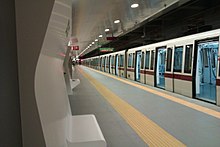

Milan Metro is the largest rapid transit system in Italy in terms of length, number of stations and ridership; and the fifth longest in the European Union and the eighth in the Europe. Seven cities have metro systems:
| City | Name | Lines | Length (km) | Stations | Opening |
|---|---|---|---|---|---|
| Brescia | Brescia Metro | 1 | 13.7 | 17 | 2013 |
| Catania | Catania Metro | 1 | 8.8 | 10 | 1999 |
| Genoa | Genoa Metro | 1 | 7.1 | 8 | 1990 |
| Milan | Milan Metro | 5 | 102.5 | 119 | 1964 |
| Naples | Naples Metro | 2 | 20.3 | 23 | 1993 |
| Rome | Rome Metro | 3 | 60 | 75 | 1955 |
| Turin | Turin Metro | 1 | 15.1 | 23 | 2006 |
Commuter rail
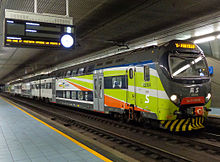
15 cities have commuter rail systems; cities without wikilink are those listed just above for their metro rail system.
- Bari (Bari metropolitan railway service, 3 lines)
- Bologna (Bologna metropolitan railway service, 8 lines)
- Cagliari, 1 line
- Catanzaro, 2 lines
- Genoa (Genoa urban railway service, 3 lines)
- Messina, 1 line
- Milan (Milan suburban railway service, 12 lines)
- Naples, 8 lines
- Palermo (Palermo metropolitan railway service, 2 lines)
- Perugia, 1 line
- Potenza, 1 line
- Reggio Calabria, 1 line
- Rome (FL lines, 8 lines)
- Salerno (Salerno metropolitan railway service, 1 line)
- Turin (Turin metropolitan railway service, 8 lines)
Airport shuttles
See also: Leonardo Express and Malpensa Express

Airport shuttle buses are highly developed and convenient for rail travellers. Most airports in Italy are not connected to the railway network, except for Rome Fiumicino Airport, Milan Malpensa Airport and Turin Caselle Airport. In Bologna, there is the monorail Marconi Express, connecting Bologna Airport to the main railway station. Linate Airport in Milan has been connected to line 4 of the Milan metro since 2022.
- Venice: Venezia-Mestre station - Marco Polo Airport (50 minutes) and Treviso Airport
- Milan: Milano Centrale station - Malpensa Airport (1 hour 5 minutes), Linate Airport (35 minutes) and Milan Bergamo Airport (1 hour)
- Brescia: Brescia station - Milan Bergamo Airport (1 hour)
- Rome: Rome Termini station - Fiumicino Airport (31 minutes)
- Verona: Verona Porta Nuova station - Villafranca "Catullo" Airport (20 minutes)
- Bologna: Centrale station - Bologna Airport (20 minutes) - Route modified in November 2020. It shifted from route BLQ (Bologna Centrale Station-Bologna Airport) to route 944 Ospedale Maggiore-Bologna Airport
- Pescara Centrale station - Abruzzo Airport (10 minutes)
- Pisa: Pisa Centrale station - San Giusto Airport (5 minutes)
- Florence: Firenze S M Novella station - Florence Airport
Tram
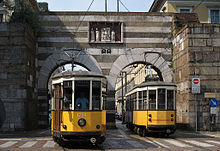
11 cities have tram system:
- Bergamo–Albino light rail
- Cagliari light rail
- Trams in Florence
- Trams in Messina
- Trams in Mestre
- Trams in Milan
- Trams in Naples
- Trams in Padua
- Trams in Palermo
- Trams in Rome
- Trams in Turin
- Trieste–Opicina tramway
Tram-train
See also: Tram-train

2 cities have tram-train system, Rome and Sassari. The Rome–Giardinetti railway connects Laziali (a regional train station some 800 metres (2,625 ft) from Termini's main concourse) with Giardinetti to the east just past the Grande Raccordo Anulare, Rome's orbital motorway. It is run by ATAC, the company responsible for public transportation in the city, which also operates the Rome Metro. The present railway is the only part of the old and longer Rome–Fiuggi–Alatri–Frosinone railway to be in service. The latest shortening of the line occurred in 2008 with the closing of the Giardinetti–Pantano section, which has now become part of the Metro Line C. The line had been due to be dismantled in 2016 to be replaced with a bus lane along Via Casilina, but in March 2015 it was announced that the line would instead be retained and modernised.
Metrosassari, also called Sassari tramway, Sassari tram-train or Sassari metro-tramway (Italian: Metrotranvia di Sassari or Italian: Metropolitana leggera di Sassari) is the commercial name of a tram-train line in Sassari, Sardinia, Italy, operated by the regional public transport company ARST (Azienda Regionale Sarda Trasporti). Despite having been built in the early 2000s, in the urban section the line was built with single track and narrow gauge, to connect with the same 950 mm (3 ft 1+3⁄8 in) gauge used in the secondary railway lines in Sardinia. The 2.45 km (1.52 mi) tramway part of the line (Stazione - Emiciclo Garibaldi) opened in October 2006, linking the railway station with the city centre via the hospital district. On 27 September 2009 the line was extended into the peripheral district of Santa Maria di Pisa, running on the electrified portion of the Sassari–Sorso railway. The main part of the network was in 2013 in the advanced development phase. It is under construction is the extension of the line from Santa Maria di Pisa to Li Punti and Baldinca, and the electrification of the railway to Sorso, 10 km from Sassari. It is also planned to convert and electrify the 28 km Sassari-Alghero railway to allow the trams to reach the village of Olmedo, Fertilia Airport and the town of Alghero.
Rail links to adjacent countries
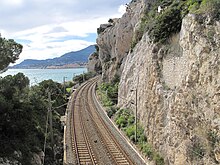

Italy has 11 rail border crossings over the Alpine mountains with her neighbouring countries: six are designated as mainline tracks and two are metre-gauge tracks. The six mainline border crossings are: two with France (one for Nice and Marseille; the other for Lyon and Dijon), two with Switzerland (one for Brig, Bern and Geneva; the other for Chiasso, Lugano, Lucerne and Zürich), and two with Austria (one for Innsbruck; the other for Villach, Graz and Vienna). The two-metre-gauge track crossings are located at the border town of Tirano (enters Switzerland's Canton Graubünden/Grisons) and Domodossola (enters Switzerland's canton of Ticino).
There is a railway line connecting Italy's northeastern port of Trieste to Slovenia, but no passenger or freight services operate on this track. Consequently, there is no direct connections between Trieste and Ljubljana, the capital of Slovenia, despite the proximity of both cities.
- Italy-France: Marseille-Ventimiglia railway, currently EuroCity trains of Thello Milan-Marseille and one EuroNight train of RZD Moscow-Nice.
- Italy-France: Tenda line, operated by Trenitalia
- Italy-France: Fréjus Rail Tunnel at 1,338 m (4,390 ft) above sea, currently SNCF TGV trains Milan-Paris and Turin-Paris and EuroNight trains of Thello Venice-Paris
- Italy-Switzerland: Simplon Tunnel, currently EuroCity (EC) trains of SBB CFF FFS Milan-Geneva and Milan-Bern
- Italy-Switzerland: Domodossola–Locarno railway line line connecting Domodossola (Italy) with Locarno (Switzerland), operated by Ferrovie Autolinee Regionali Ticinesi SA (FART)
- Italy-Switzerland: Cadenazzo–Luino railway line connecting Luino (Italy) to Bellinzona (Switzerland) and runs on the eastern coast of Lake Maggiore, operated by TILO regional trains
- Italy-Switzerland: Mendrisio–Varese railway line connecting Varese (Italy) to Mendrisio (Switzerland), operated by TILO regional trains
- Italy-Switzerland: Milan–Chiasso railway, currently EuroCity trains of SBB CFF FFS Milan-Zürich
- Italy-Switzerland: Bernina railway at 2,253 m (7,392 ft) above sea, metre-gauge trains of RhB Tirano-St. Moritz and the Bernina Express tourist train
- Italy-Austria: Brenner railway at 1,371 m (4,498 ft) above sea, currently EuroCity trains of ÖBB-DB Munich-Verona and Munich-Venice/Bologna, and DB CityNightLine Munich-Rome/Milan
- Italy-Austria: Drava Valley Railway at 1,175 m (3,855 ft) above sea connecting San Candido/Innichen (Italy) and Lienz (Austria)
- Italy-Austria: Rudolf Railway connecting Venice and Udine (Italy) to Villach (Austria), currently EuroCity trains of ÖBB Venice-Vienna, EuroNight trains of ÖBB Vienna-Rome/Milan, and DB CityNightLine Munich-Venice
- Italy-Slovenia: Tarvisio–Ljubljana Railway
The Vatican City is also linked to Italy with a railway line serving a single railway station, the Vatican City railway station. This line is used only for special occasions. San Marino used to have a narrow gauge rail connection with Italy; this was dismantled in 1944.
All links have the same gauge.
 Austria — voltage change 3 kV DC/15 kV AC
Austria — voltage change 3 kV DC/15 kV AC France — voltage change 3 kV DC/25 kV AC or 1.5 kV DC
France — voltage change 3 kV DC/25 kV AC or 1.5 kV DC Slovenia — same voltage
Slovenia — same voltage Switzerland — voltage change 3 kV DC/15 kV AC (plus two narrow gauge lines, same voltage)
Switzerland — voltage change 3 kV DC/15 kV AC (plus two narrow gauge lines, same voltage) Vatican City — no electrification
Vatican City — no electrification San Marino — closed, narrow gauge
San Marino — closed, narrow gauge

Stations on the border are:
- Roma San Pietro is the border station of the Rome-Vatican City railway
- Ventimiglia is the border station on the Genoa-Nice main line.
- Olivetta San Michele and Limone Piemonte on both sides of the Tenda Railway
- Modane is the border station on the Turin-Lyon main line (Fréjus Tunnel line).
- Domodossola is the border station of the Milan-Bern/Geneva main line (Simplon Tunnel line).
- Ribellasca is on the Vigezzina.
- Luino is the border station of the Oleggio–Pino railway.
- Chiasso is the border station of the Milan-Zürich main line (Gotthard Tunnel line).
- Tirano is the terminus on the Italian side of the 1,000 mm (3 ft 3+3⁄8 in) Bernina line of the Rhätische Bahn.
- Brenner is the border station of the Verona-Innsbruck main line (Brenner railway).
- San Candido is the border station of the Fortezza-Lienz secondary line.
- Tarvisio Boscoverde is the border station of the Venezia-Wien main line (Austrian Southern Railway line).
- Gorizia Centrale station serves as link to the Slovenian Railways, through the station of Nova Gorica, which can be entered also directly by pedestrians from the Italian side.
- Villa Opicina (Villa Opicina, Trieste) serves as link to the Slovenian Railways, through the stations of Sežana and Repentabor.
Heritage railways
See also: List of heritage railways in Italy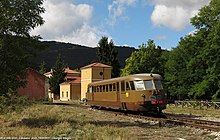
In Italy, the heritage railways institute is recognized and protected by law no. 128 of 9 August 2017, which has as its objective the protection and valorisation of disused, suspended or abolished railway lines, of particular cultural, landscape and tourist value, including both railway routes and stations and the related works of art and appurtenances, on which, upon the proposal of the regions to which they belong, tourism-type traffic management is applied (art. 2, paragraph 1). At the same time, the law identified a first list of 18 tourist railways, considered to be of particular value (art. 2, paragraph 2).
The list is periodically updated by decree of the Ministry of Infrastructure and Transport, in agreement with the Ministry of Economy and Finance and the Ministry of Culture, also taking into account the reports in the State-Regions Conference, a list which in 2022 reached 26 railway lines. According to article 1, law 128/2017 has as its purpose: "the protection and valorisation of railway sections of particular cultural, landscape and tourist value, which include railway routes, stations and related works of art and appurtenances, and of the historic and tourist rolling stock authorized to travel along them, as well as the regulation of the use of ferrocycles".


Below is the list of railway lines recognized as tourist railways by Italian legislation.
a) pursuant to art. 2 paragraph 2 law 128/2017:- Sulmona-Castel di Sangro section of the Sulmona–Isernia railway [it]
- Cosenza-Camigliatello–San Giovanni in Fiore railway [it]
- Avellino–Rocchetta Sant'Antonio railway [it]
- Gemona del Friuli–Sacile railway [it]
- Palazzolo–Paratico railway [it]
- Castel di Sangro-Carpinone section of the Sulmona-Isernia railway
- Ceva–Ormea railway
- Mandas–Arbatax railway [it]
- Isili–Sorgono railway [it]
- Sassari–Tempio-Palau railway
- Macomer–Bosa railway [it]
- Alcantara–Randazzo railway [it]
- Castelvetrano-Porto Palo section of the Castelvetrano–Porto Empedocle railway [it]
- Agrigento Bassa-Porto Empedocle section of the Castelvetrano-Porto Empedocle railway
- Noto–Pachino railway [it]
- Asciano–Monte Antico railway
- Civitavecchia–Orte railway [it]
- Fano–Urbino railway [it]
|
b) pursuant to the Ministerial Decree of 30 March 2022:
|

The Bernina railway line is a single-track 1,000 mm (3 ft 3+3⁄8 in) metre gauge railway line forming part of the Rhaetian Railway (RhB). It links the spa resort of St. Moritz, in the canton of Graubünden, Switzerland, with the town of Tirano, in the Province of Sondrio, Italy, via the Bernina Pass. Reaching a height of 2,253 metres (7,392 ft) above sea level, it is the third highest railway crossing in Europe. It also ranks as the highest adhesion railway of the continent, and – with inclines of up to 7% – as one of the steepest adhesion railways in the world. The elevation difference on the section between the Bernina Pass and Tirano is 1,824 m (5,984 ft), allowing passengers to view glaciers along the line. On 7 July 2008, the Bernina line and the Albula railway line, which also forms part of the RhB, were recorded in the list of UNESCO World Heritage Sites, under the name Rhaetian Railway in the Albula / Bernina Landscapes. The whole site is a cross-border joint Swiss-Italian heritage area. Trains operating on the Bernina line include the Bernina Express.
In July 2023, Ferrovie dello Stato established a new company, the "FS Treni Turistici Italiani" (English: FS Italian Tourist Trains), with the mission "to propose an offer of railway services expressly designed and calibrated for quality, sustainable tourism and attentive to rediscovering the riches of the Italian territory. Tourism that can experience the train journey as an integral moment of the holiday, an element of quality in the overall tourist experience". There are three service areas proposed:
- Luxury trains, which includes the circulation of the "Orient Express - La Dolce Vita" from 2024, and Venice Simplon Orient Express, already operating on European routes;
- Express and historic trains, with the express trains of the 1980s and 1990s being redeveloped and modernized in the railway workshops of Rimini, while the historic trains are used for journeys that include stops with guided tours and tastings;
- Regional trains, also with trips that include experiential tourist stops, which pass through places rich in history, with villages and areas of landscape, naturalistic, food and wine and agri-food interest.
Funding
The Italian railways are partially funded by the government, receiving €8.1 billion in 2009.
Categories and types of trains
See also: Train categories in EuropeThese are the major service categories and models of Italian trains.
-
 Italo operates on main High-Speed lines by NTV. Makes a few stops in the most important cities.
Italo operates on main High-Speed lines by NTV. Makes a few stops in the most important cities.
-
 Frecciarossa operates on High-Speed lines by Trenitalia. Makes a few stops in major cities.
Frecciarossa operates on High-Speed lines by Trenitalia. Makes a few stops in major cities.
-
 Frecciargento operates on High-Speed lines by Trenitalia. Makes some stops in big cities.
Frecciargento operates on High-Speed lines by Trenitalia. Makes some stops in big cities.
-
 Frecciabianca operates on main lines by Trenitalia. Stops in big cities.
Frecciabianca operates on main lines by Trenitalia. Stops in big cities.
-
 Intercity operates on main lines by Trenitalia. Stops in big cities.
Intercity operates on main lines by Trenitalia. Stops in big cities.
-
 Eurocity, formerly Cisalpino, operates on international main lines within the European Union by Trenitalia. Stops in big cities.
Eurocity, formerly Cisalpino, operates on international main lines within the European Union by Trenitalia. Stops in big cities.
-
 RegionaleVeloce operates on regional lines in a region or in adjacent regions by Trenitalia. Stops in the main stations of the local service.
RegionaleVeloce operates on regional lines in a region or in adjacent regions by Trenitalia. Stops in the main stations of the local service.
-
 Regionale operates on regional lines by Trenitalia. Stops in every station of the local service.
Regionale operates on regional lines by Trenitalia. Stops in every station of the local service.
-
 Regio-Express operates on regional lines by Trenord. Stops in some stations of the local service.
Regio-Express operates on regional lines by Trenord. Stops in some stations of the local service.
-
 RegionaleVeloce as operates in the Aosta Valley by Trenitalia
RegionaleVeloce as operates in the Aosta Valley by Trenitalia
-
 RegionaleVeloce as operates in Veneto by Trenitalia
RegionaleVeloce as operates in Veneto by Trenitalia
-
 Regionale as operates in Trentino-Alto Adige by SAD
Regionale as operates in Trentino-Alto Adige by SAD
-
 Regionale as operates in some lines of Veneto by Sistemi Territoriali (ST)
Regionale as operates in some lines of Veneto by Sistemi Territoriali (ST)
-
Regionale as operates in Friuli-Venezia Giulia by Società Ferrovie Udine-Cividale (FUC)
-
 Regionale as operates in Apulia by Ferrovie del Sud Est (FSE)
Regionale as operates in Apulia by Ferrovie del Sud Est (FSE)
Main stations
-
 Bari Centrale, Bari
Bari Centrale, Bari
-
Bologna Centrale, Bologna
-
 Firenze Santa Maria Novella, Florence
Firenze Santa Maria Novella, Florence
-
 Genova Brignole, Genoa
Genova Brignole, Genoa
-
 Genova Piazza Principe, Genoa
Genova Piazza Principe, Genoa
-
 Milano Cadorna, Milan
Milano Cadorna, Milan
-
 Milano Centrale, Milan
Milano Centrale, Milan
-
 Milano Porta Garibaldi, Milan
Milano Porta Garibaldi, Milan
-
 Napoli Centrale, Naples
Napoli Centrale, Naples
-
 Palermo Centrale, Palermo
Palermo Centrale, Palermo
-
 Roma Ostiense, Rome
Roma Ostiense, Rome
-
 Roma Termini, Rome
Roma Termini, Rome
-
 Roma Tiburtina, Rome
Roma Tiburtina, Rome
-
 Trieste Centrale, Trieste
Trieste Centrale, Trieste
-
 Torino Porta Nuova, Turin
Torino Porta Nuova, Turin
-
 Torino Porta Susa, Turin
Torino Porta Susa, Turin
-
 Venezia Mestre, Venice
Venezia Mestre, Venice
-
 Venezia Santa Lucia, Venice
Venezia Santa Lucia, Venice
-
 Verona Porta Nuova, Verona
Verona Porta Nuova, Verona
See also
- Ferrovie dello Stato Italiane
- History of rail transport in Italy
- Railway stations in Italy
- Transport in Italy
- Trenitalia
- Treno Alta Velocità
- Rail transport in Europe
References
- "Railway passenger transport statistics" (PDF). Europa EU. 8 December 2019. Retrieved 9 January 2021.
- ^ "La rete oggi" [Rail network] (in Italian). RFI Rete Ferroviaria Italiana. 31 December 2023.
- Total length of tracks: double tracks are counted twice.
- Compare List of countries by rail transport network size.
- "Il sistema di elettrificazione a 25kV c.a." RFI Rete Ferroviaria Italiana. Retrieved 16 November 2011.
- "Domestic train fees per country". Eurail. Retrieved 7 December 2024.
- "Rail Passes - ItaliaRail - Italy Train Ticket and Rail Pass Experts". italiarail.com.
- "Special report: A European high-speed rail network". op.europa.eu. Retrieved 22 July 2023.
- "La Dolce Vita? Italy By Rail, 1839-1914 | History Today". History Today. Retrieved 29 December 2019.
- "Le ferrovie nell'Unità d'Italia. Cronologia storica 1839-1861". Fondazione FS. Retrieved 3 October 2023.
- "Prospetto cronologico dei tratti di ferrovia aperti all'esercizio dal 1839 al 31 dicembre 1926". Ufficio Centrale di Statistica delle Ferrovie dello Stato. 1927. Retrieved 11 May 2023.
- Gian Guido Turchi (2006). Strade Ferrate Meridionali: ultimo atto (in Italian). Edizioni ETR. pp. 13–14.
- Cesare Columba, Da Firenze a Bologna bucando l'Appennino in, VdR 1839-1939: i centocinquant'anni delle ferrovie italiane, pp. 26-28
- Cornolo Giovanni. Una leggenda che corre: breve storia dell'elettrotreno e dei suoi primati; ETR.200 – ETR.220 – ETR 240. ISBN 88-85068-23-5
- Paolo Lavadas; Mauro Luoni (2011). 1861-2011, 150°, L'unità d'Italia attraverso le ferrovie (in Italian). Editoriale del Garda. p. 21.
- "Ferrovie dello Stato" (in Italian). Retrieved 20 August 2008.
- "Frecciarossa 1000 in Figures". Ferrovie dello Stato Italiane. Archived from the original on 18 December 2014. Retrieved 24 November 2014.
- "Frecciarossa 1000 Very High-Speed Train". Railway Technology. Archived from the original on 9 August 2015. Retrieved 5 May 2016.
- "French Train Breaks Speed Record". CBC News. Archived from the original on 5 August 2020. Retrieved 5 June 2019.
- "Due record in prova per il Frecciarossa" (in Italian). Repubblica. 4 February 2009. Retrieved 5 February 2009.
- "Viaggia con i treni Frecciarossa e acquista il biglietti a prezzi scontati - Le Frecce - Trenitalia". trenitalia.com (in Italian). Retrieved 14 May 2017.
- "Ferrovie: Ecco il progetto della AV/AC Salerno-Reggio Calabria" (in Italian). Retrieved 8 February 2021.
- "Alta velocità ferroviaria SA-RC, come cambiano gli scenari" (in Italian). Retrieved 21 February 2024.
- "Alta velocità ferroviaria Salerno-Reggio e Palermo-Catania Messina: aggiudicati lavori per altri 3,7 miliardi" (in Italian). Retrieved 21 February 2024.
- "Alta velocità Napoli-Bari. Partiti i lavori. Sei miliardi per collegare le due città in 2 ore a 40 minuti" (in Italian). Retrieved 21 February 2024.
- "Treno ad alta velocità Le Frecce" (in Italian). Retrieved 24 September 2024.
- "Ferrovie.it - A 300 km/h da Milano a Brescia". Ferrovie.it (in Italian). Retrieved 20 June 2024.
- "Trenitalia". www.lefrecce.it. Retrieved 20 June 2024.
- "Italotreno.com". biglietti.italotreno.com. Retrieved 20 June 2024.
- "Roma Termini - Roma Termini - Grandi Stazioni". Archived from the original on 11 November 2014. Retrieved 12 November 2022.
- "Stazione di Milano Centrale - Info Stazione Milano Centrale - Tour Virtuale stazione | Milano Centrale". www.milanocentrale.it (in Italian). Archived from the original on 27 November 2019. Retrieved 29 April 2019.
- "Torino Porta Nuova - Torino Porta Nuova - Grandi Stazioni". Archived from the original on 15 June 2011. Retrieved 12 November 2022.
- "Firenze S. Maria Novella - Firenze S. Maria Novella - Grandi Stazioni".
- "Bologna Centrale - Bologna Centrale - Grandi Stazioni". Archived from the original on 10 February 2012. Retrieved 12 November 2022.
- "Roma Tiburtina - Roma Tiburtina - Grandi Stazioni". Archived from the original on 17 March 2015. Retrieved 12 November 2022.
- "Napoli Centrale - Napoli Centrale - Grandi Stazioni". Archived from the original on 8 August 2017. Retrieved 13 January 2017.
- Bilancio Sociale "LeNord" 2004-2005
- ^ "Venezia Mestre - Venezia Mestre - Grandi Stazioni". Archived from the original on 8 September 2018. Retrieved 12 November 2022.
- "Effetto M4: la metro di Milano entra nella top europea" (in Italian). Retrieved 12 October 2024.
- "Perché a San Francisco girano (anche) i tram di Milano" (in Italian). Retrieved 25 October 2024.
- "Il Libro Giallo del Trenino". CityRailways (in Italian). Retrieved 22 April 2015.
- Piccirilli, Antonio (25 June 2013). "Un 'carro bestiame' nel cuore della città: quale futuro per la Roma-Giardinetti?". Roma Today (in Italian). Retrieved 22 April 2015.
- "Metro C, apre la Pantano-Centocelle: folla di romani all'inaugurazione". Retrieved 23 July 2018.
- Bisbiglia, Vincenzo (25 January 2015). "Trenino Roma-Giardinetti, la corsa è finita". Il Tempo (in Italian). Retrieved 22 April 2015.
- Sina, Ylenia (19 March 2015). "La Roma Giardinetti devierà sulla Togliatti: destinazione Tor Vergata". Roma Today (in Italian). Retrieved 22 April 2015.
- (in Italian) ARST - Metrosassari
- (in Italian) Azienda Trasporti Pubblici Sassari - Informazioni Archived 1 February 2016 at the Wayback Machine
- (in Italian) Andrea Spinosa - Progetto tram-treno Archived 9 November 2011 at the Wayback Machine
- (in Italian)Comune di Benevento - SCHEDA n° 2 Sassari, Italia, Tram Treno
- (in Italian) Elena Molinaro, Linee guida tram treno, Ministero delle Infrastrutture e dei Trasporti, atti del 5º convegno nazionale Sistema Tram, Roma, 1 gennaio – 1 febbraio 2013.
- "Metros January 2007". Railway Gazette International. 1 January 2007. Archived from the original on 9 August 2011. Retrieved 27 July 2010.
- (in Italian) Lestradeferrate.it - Stazione di Santa Maria di Pisa
- (in Italian) Tram oltre Sassari. In: ″I Treni″ Nr. 320 (November 2009), p. 8.
- "La Ferrovia dello Stato della Città del Vaticano" (in Italian). Sala stampa della Santa Sede. Retrieved 9 January 2012.
- "la "Ferrovia Rimini - San Marino"" (in Italian). ferroviedismesse.com. Archived from the original on 24 February 2020. Retrieved 6 January 2012.
- ^ Gazzetta Ufficiale della Repubblica Italiana. "Legge 9 agosto 2017, n. 128".
- ^ "Tratte ferroviarie ad uso turistico" (PDF) (in Italian). Retrieved 24 February 2024.
- ^ A ordinary gauge, owned by RFI.
- A narrow gauge, regional railway owned by Calabria railways [it]; the service is called Trenino della Sila [it].
- Subsequently extended to Isernia.
- ^ A narrow gauge, regional railway owned by ARST; the service is called Trenino Verde.
- ^ Line part of the disused narrow gauge FS network of Sicily.
- A ordinary gauge, regional railway owned by Ferrovienord.
- ^ "Gruppo FS, nasce la nuova società "FS Treni Turistici Italiani"" (in Italian). Retrieved 24 February 2024.
- "The age of the train" (PDF). Archived from the original (PDF) on 17 November 2015. Retrieved 14 November 2015.
Bibliography
- Parks, Tim (2013). Italian Ways: On and Off the Rails from Milan to Palermo. London: Harvill Secker. ISBN 9781846557743.
- Fascicolo Linea 82 bis – AV/AC Torino – Milano – Napoli Tratto di linea Milano Rogoredo – Firenze Castello e relative interconnessioni con linea Milano – Bologna – Firenze (Tradizionale) (in Italian). Rete Ferroviaria Italiana. pp. 90–119 and 150–179.
External links
- RFI (Infrastructure manager) Official website (Italian only)
- Lyon Turin Ferroviaire
- Railway Technology.com article on Italian High-Speed Rail, including NTV, Accessed 5 February 2008
- Italian HS System
| Rail transport in Europe | |
|---|---|
| Sovereign states |
|
| States with limited recognition | |
| Dependencies and other entities | |
| Other entities | |